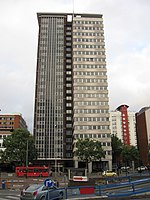Ruskin Square
Buildings and structures in the London Borough of CroydonBuildings and structures under construction in the United KingdomCroydon 2020Redevelopment projects in London

Ruskin Square (or Croydon Gateway) is a project to redevelop a parcel of land between East Croydon railway station and the existing town centre of Croydon in South London. It is part of the major Croydon Vision 2020 regeneration scheme. It has been subject to substantial public debate which has featured in the national media. Croydon is the principal office district in South London, having been rebuilt on a large scale in the 1960s, but much of the remaining office stock from that era is now dated. The "Croydon Gateway" site, a former railway goods yard, represents the largest single development opportunity in the district.
Excerpt from the Wikipedia article Ruskin Square (License: CC BY-SA 3.0, Authors, Images).Ruskin Square
Ruskin Square, London Broad Green (London Borough of Croydon)
Geographical coordinates (GPS) Address Nearby Places Show on map
Geographical coordinates (GPS)
| Latitude | Longitude |
|---|---|
| N 51.376 ° | E -0.0941 ° |
Address
1 Ruskin Square
Ruskin Square
CR0 2WF London, Broad Green (London Borough of Croydon)
England, United Kingdom
Open on Google Maps











